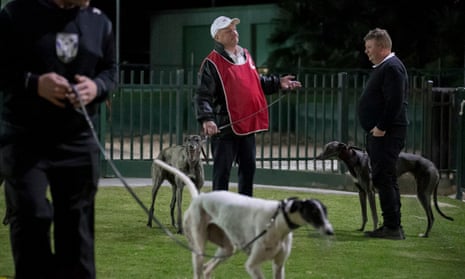“The government’s response will close an industry and sport that had been central to working class culture in NSW …”
That’s the Sydney Morning Herald reporting on greyhound racing.
But what, precisely, is working class culture? How should progressives relate to it in an era in which the inner city suburbs once most associated with blue collar occupations are changing beyond recognition?
It’s not a simple question.
“Greyhounds,” notes Jeff Collerson in an impassioned defence of the sport in the Daily Telegraph, “have always given pleasure to working-class citizens.”
That’s certainly true. But there’s more to the argument than that. After all, the vast majority of Australians work for a living – and that means that all mass culture depends, almost by definition, on working class consumption.
Or, to put it another way, any popular recreation gives pleasure – merely by virtue of its popularity – to working class citizens.
Australian Rules Football depends on the ordinary people trooping into the stands each week. But if footy’s part of working class culture, what about the movies? After all, Hollywood would go bust if everyday folk stopped buying tickets. We could say the same about comic publishers and big museums and computer game developers: they all rely on workers.
Right now, for instance, it’s probably safe to wager that more working class kids are chasing Pokemons than watching dog races.
In any case, successful cultural forms become – again, almost by definition – big business, something that complicates matters further. In a legal sense, the “owners” of culture will always be businessmen, not fans. Hip hop performers might arise from the ghetto but record company executives live in penthouses.
Culture-as-industry thus presents obvious problems for culture-as-class- expression.
Throughout the 20th century, activists in the labour movement spearheaded many cultural interventions, some of which still reverberate today.
In August 1950, for instance, Frank Hardy’s Power Without Glory was celebrated at the Athenaeum Gallery in Melbourne’s Collins Street, with what was purportedly the first ever book “launch” in Australia. The novel – a thinly-veiled expose of political corruption – had been printed surreptitiously, its pages collated and compiled by volunteers from the trade union movement. By September, Smith’s Weekly declared that “all Melbourne is talking about Power without Glory” with book sellers reporting “all-time record sales for any local or overseas book”.
Hardy’s success inspired the Australasian Book Society, a co-operative publishing and distribution project with close links to the trade unions. Joe Waters, one of its founders, explained its genesis:
It was this eagerness of workers, waterside workers, meat workers, everybody you can think of, ordinary people wanting to read Power Without Glory, which did impress me more than anything else. It seemed to me that there were new fields opening up for writers and book publishers.
At its height, the ABS was distributing new novels to some 3000 (mostly working class) members – a remarkable figure for the small Australian market and a significant contribution to literary life at a time when few commercial publishers would consider local novels (and almost none would accept books discussing sex or radical politics).
Labour movement activists played equally important roles in championing other cultural forms initially frowned upon by a conservative mainstream. Australian jazz, for instance, owes a great deal to the efforts of the young communists of the Eureka Youth League, who staged the first ever Australian Jazz Convention in 1946, at a time when the right-wing Argus fulminated against the new fangled jukebox for attracting teenagers to taverns: “First they go innocently to play the juke box, then they start to drink; then heavens know what!”
Likewise, today’s massive Melbourne International Festival stems from an event staged in 1952 by the Australian Council of Film Societies, a group so closely linked to the Communist Party that ASIO put the first festival under immediate surveillance. “The overall picture of the Film Festival,” an agent reported, “appears to show that communists, communist sympathisers and communist organisations were very much in evidence …”
But who today thinks of film appreciation as a working class hobby?
The greyhound controversy provides an interesting illustration of why the class label remains attached in public consciousness to some cultural activities and not to others.
Labour historian Paul Tracey contends that the way we think about greyhounds stems from the tumult taking place in NSW in the 1920s and 30s. Specifically, the rise of “tin hare” racing coincided with the rise of Jack Lang, the Labor radical lauded by supporters as “greater than Lenin”. Dog racing acquired its reputation because Lang championed it as part of his populist program.
“Lang’s hammering of the theme,” Tracey says, “that the workers’ greyhound racing was being attacked while the rich continued to enjoy their racing without state or moralist interference fitted neatly with the reality of depression age politics when workers bore the brunt of economic conditions and social criticism.”
That history makes the defences of greyhound racing mounted by Barnaby Joyce and other National Party MPs seem quite odd: these are not exactly people you’d associate either with libertarianism or Langite Laborism.
But if we look more closely, there’s something else going on.
Take, for example, the Daily Telegraph’s Miranda Devine’s intervention. She makes a point of lauding what she calls the “culture that greyhounds represent – of male battlers in regional Australia hanging onto their dignity, whose main social interaction is a night at the doggies” and contrasting that with the sensibilities of those she holds responsible for the ban: “vegan GetUp! Activists … with nose piercings and psychological hangups.”
Certainly, there are strands of class-based moralism running through green politics today (think of Richard di Natale’s embrace of so-called sin taxes like the proposed levy on sugary drinks – a measure that reeks of tut-tutting paternalism). And there are legitimate questions to be asked about the job losses attendant upon Baird’s policy.
You can see how greyhound racing has become talismanic for rightwing pundits: not because it signifies the mainstream of working class life but precisely because it doesn’t. As sports historian Steve Georgakis argues, it’s “assumed a mythical aspect of an ever-disappearing ‘old’ Australian way of life … ‘A night at the dogs’ represent[s] a step back into time.”
All too often, that’s what media valorisations of “working class culture” entail. Even when well intentioned, they’re generally tinged with a paternalistic nostalgia, with workers featuring as cloth-capped relics of a vanishing past. We don’t hear about the trade unionists fighting with Frank Hardy to distribute an important novel. Instead, we’re presented with working class people as an endangered species, requiring the benevolent protection of sympathetic politicians or journalists.
Which is not to say that there’s nothing to be learned from the history of the working class. During Lang’s second term as premier, he became an emblem of resistance to the austerity measures being implemented in the midst of an economic crisis. His rise and fall thus poses some remarkably contemporary issues for ordinary Australians, whether their noses are pierced or not.
But to address those debates, you need to shift from talking about about working class culture to talking about working class politics – a very different matter entirely.

